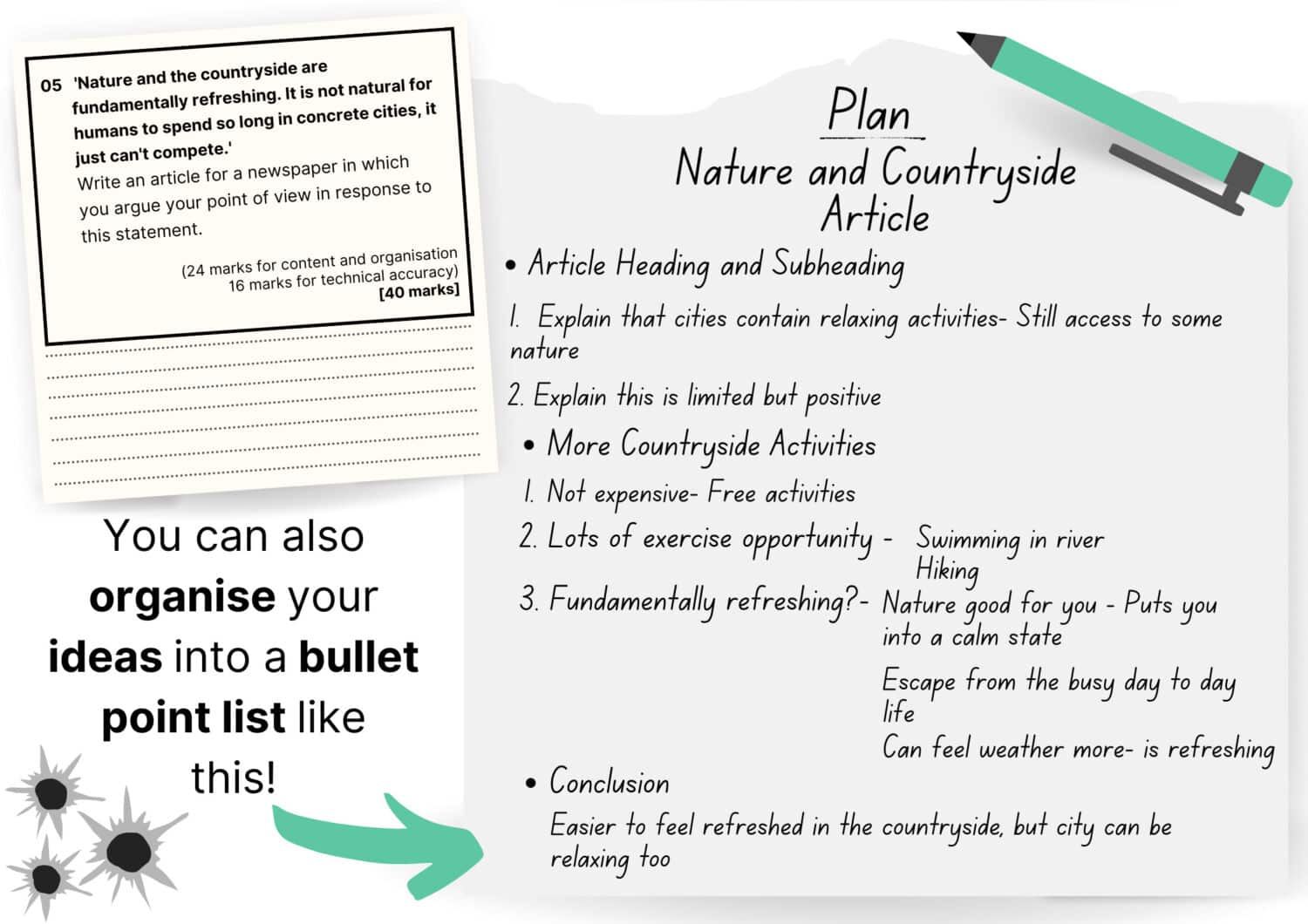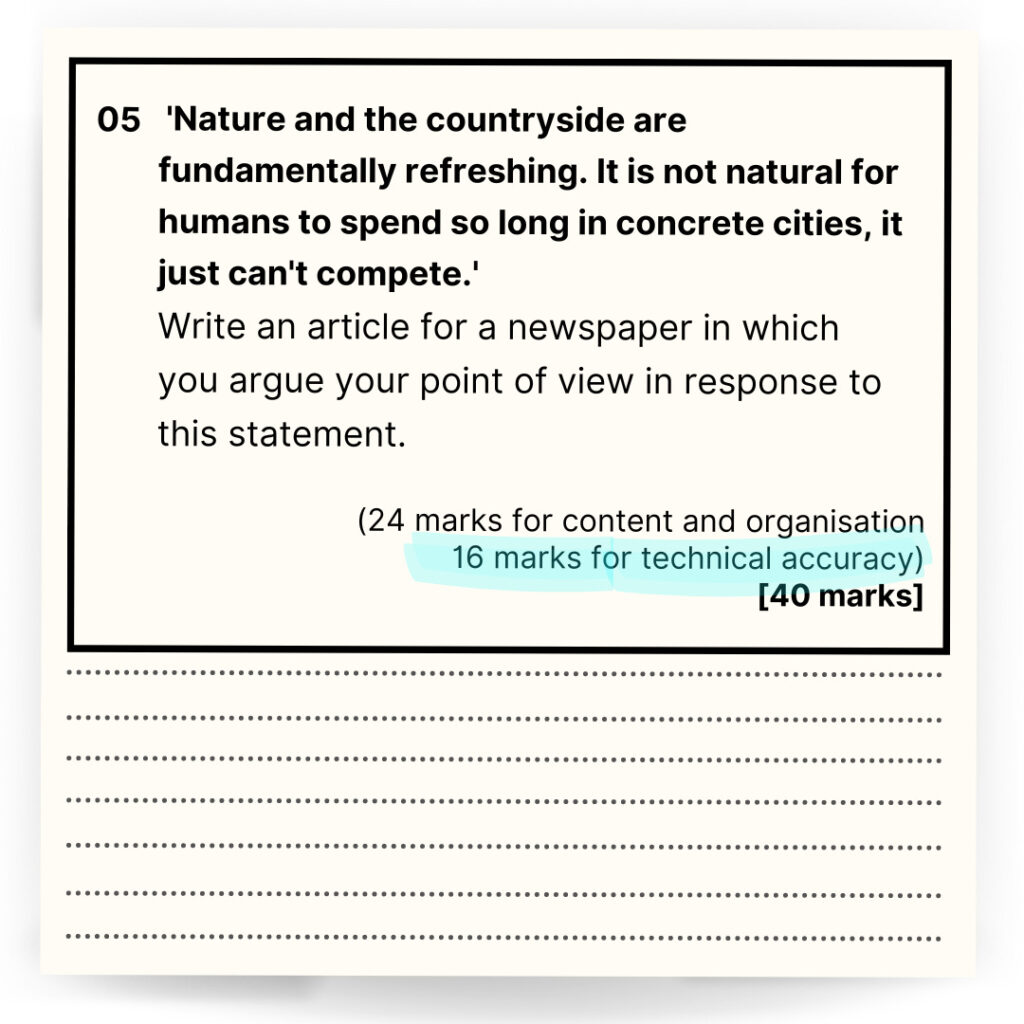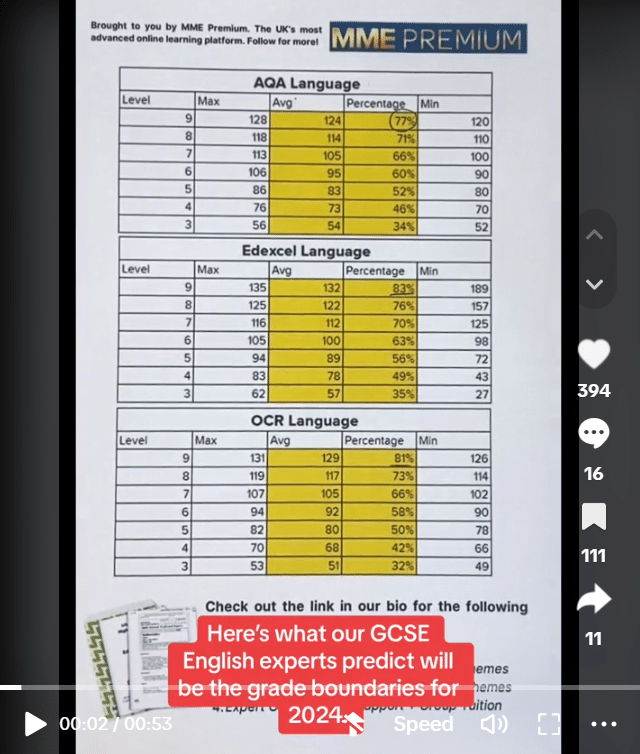Writing: Crafting Non-Fiction
Writing: Crafting Non-Fiction Revision
Writing: Crafting Non-Fiction
In your English Language GCSE exam, you will not only be tested on your ability to read and understand, but also to understand and write.
The writing section of the paper and the skills you demonstrate within it are just as important as the reading section, even though there are fewer questions.
This page aims to help you prepare to meet these demands with confidence and skill, and will also help equip you to write multiple different kinds of texts in your everyday life.
Planning
The next, crucial step after reading the question on your paper is planning.
In the same way that making a complex and delicious meal is easier with a recipe, when you are writing a complex text, a well-structured plan is also very helpful.
In order to plan your text, you should read the question carefully, and pick out any of the key words in order to figure out your audience, aim, and tone.
You should also make sure that you know who you are writing the text for, as this will help you to determine the level of detail you should include, and to whom it should be addressed.
Your audience and aim (what you are trying to achieve with the text) will usually be clearly stated in the question, will also help you to to decide the tone in which you write…
- Texts which are meant for individuals you are unfamiliar with or know professionally should have a more formal and professional tone.
- Texts which are meant for individuals you are very familiar with or know personally, should have a less formal and casual tone.
There are lots of different ways in which you can plan your text, here we will go through some of the most common ones, and when they may be more or less applicable.
Methods of Planning:
Bullet Points
Bullet points help you to split up information into bite-sized pieces, and to break up ideas which seem complicated.
By visually separating points which feel very long or complex into different points, you can help yourself to create a much more coherent text.

One of the main difficulties when writing a non-fiction text can be to make sure that the points follow a logical path and that each paragraph builds upon the ideas of the others.
Using numbered bullet points can also be a good way to do this.
Bullet points help this to be done easily, and also makes it simpler to follow your plan, making sure nothing has been missed from the key parts of the question.
Spider Diagrams
Spider diagrams, also called mind maps, are very helpful when you have lots of ideas, or a more complex text to write.

This is because it makes it easy to begin with the central idea or aim, here a review of a holiday home, and grow it outwards while creating visual connections.
This can be especially useful as you are developing an idea, as it gives you plenty of room to add extra thoughts in.
It also helps you to see where paragraphs of your text could be linked, and therefore often makes it easier to create a cohesive and well-connected text.
Subheadings
Using subheadings in a plan can often be the second step of planning, once you have generated your ideas using a spider diagram or brief bullet points.
However, in your exam you may not always have enough time to do this two-step process.
Instead, in your exam, you might prefer to put your plan straight into this format, and to help you make sure that your notes are in a logical order.

They are helpful when the text you need to create has clearly defined sections, and you know which order they should be written in.
They are also useful in helping to ensure that your text has a clear beginning, middle and end, and are therefore useful if you find that you struggle with structuring your texts well.
Structuring
When you are structuring your non-fiction text, it is important that you make sure any relevant or key details in the question are covered.
These details are included to help you and will give you vital clues as to what your:
aim
audience
and tone
…should be.
When they are marking your text, the examiner will look for a demonstration of certain skills, and these will be guided by the government specification for the GCSE English Language qualification.
These skills are given the term ‘Assessment Objectives‘, or AOs for short, let’s take a closer look at what the two which are related to your writing tasks are…

AO5:
Communicate clearly, effectively and imaginatively, selecting and adapting tone, style and register for different forms, purposes and audiences. Organise information and ideas, using structural and grammatical features to support coherence and cohesion of texts.
AO6:
Candidates must use a wide range of vocabulary and sentence structures for clarity, purpose and effect, with accurate spelling and punctuation.
As we can see here, it is essential that your text is well-structured, in order for you to achieve full marks in the writing tasks.
Making sure that you are using a wide variety of sentence types correctly, and with correct grammar, is the first, essential step to building a well-structured text.
Both the bullet point plan and the subheading plan shown above are useful for ensuring you have created a thorough and logical structure in your answer.
For non-fiction texts such as articles and letters, you may wish to plan using one of these formats.
When you have a lot to think about, such as in your exam, it can be easier to miss out these essential components, so planning it into your answer at the most basic level will help you to avoid this pitfall, and losing easy marks.
Checking
Just as it is important to check your answers in the reading and fictional writing sections of your exam, it is also essential to check your non-fiction answer.
You can lose or gain a lot of marks for the correct use of spelling, punctuation and grammar, so don’t underestimate the power of going back and looking for any errors in these areas.
This might include checking for:
- Correct use of grammar – Including capital letters, contractions, and word order.
- Correct use of punctuation – Including speech marks where necessary, appropriate use of commas, full stops and more advanced punctuation such as hyphens and colons.
- Appropriate use of language features – Including less emotive language in formal texts, and more metaphors or idioms in informal texts.
- Appropriate use of tone – Including the correct amount of contractions and personal and impersonal voice for formal and informal texts.

As we can see on this example question, there are usually a high number of marks allotted for the quality of SPaG (spelling, punctuation and grammar), and it is therefore vital that you take this into consideration before finalising your answer.
This is what is meant by the term ‘Technical Accuracy‘.
It is also important to ensure that the ‘Content and Organisation‘ is correct according to the question instructions.
This involves checking that the text type you have produce is the correct one, and that you have included the key organisational features in your text.
For example…
Here, the correct organisation of the text would be in the format of an article, and therefore should include a heading and subheading, in addition to paragraphs.
The correct content would be an argument made for, against, or on both sides of the statement in the question, and would need to demonstrate an original and relevant line of thought, as this is what the question asks for.
When it comes to actually writing your answer, we have several more pages which help you to deal with the specifics of text type, language use, and structure use, so make sure that you also read these carefully.

MME Premium Membership
£19.99
/monthLearn an entire GCSE course for maths, English and science on the most comprehensive online learning platform. With revision explainer videos & notes, practice questions, topic tests and full mock exams for each topic on every course, it’s easy to Learn and Revise with the MME Learning Portal.
Sign Up Now

